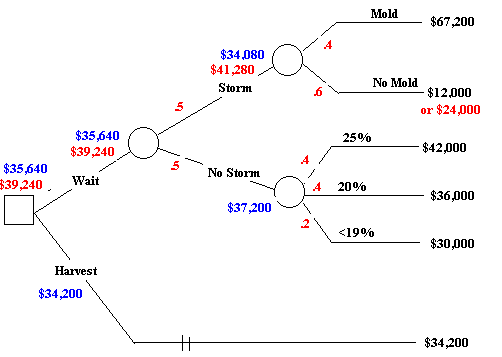BUS 202 Quantitative Applications
Freemark Abbey:
The following are short possible answers to the questions posed in the
case. Obviously your answers may differ from these and hopefully discuss
the case more fully than just to answer questions.
-
At the outset there are two alternatives: (1) wait (W) for the storm
to hit, if it will; (2) Harvest (H) now. If waited, the storm may
or may not hit. If it hits the mold may or may not form grately affecting
the revenue. If the storm hits and no mold forms, the eventual sugar level,
which determines the quality of the wine and hence the revenue, is uncertain.
Likewise the uncertainty about the mold is quite important as it
determines the difference between an exquisite wine versus a thin wine
that the vinery may be unwilling to risk their reputation by selling it
under company label. This calls for another decision (if storm hits
and the mold does not form): whether to sell the grapes in bulk (B)
or make the thin wine and sell it under label (T). This decison
however is different in that the EV will always favor making the wine since
EV maximizes the current returns but cannot consider the long term marketing
impact of selling the thin wine now. Thus this decision must be made outside
the framework of the sequential decison based on monetary EV.
-

According to the above decision tree, solved on the assumption of (B),
waiting for the storm has an EV of $35,640 versus (H) with an inferior
EV of $34,200. Admittedly the diffrence is rather small (about 4.2% higher).
If (T) is used the EV of (W) goes upto 39,240 which is substaintially
more. However one has to cosider the negative long term effects of (T).
-
If the probablity of the mold is only 20% the (W)'s
EV drops to $30,120, making (H), the better alternative, not only
in higher EV as well as lower risk.
-
Again assuming (B) is used, EVPI (storm) can be calculated as follows:
EV with prior knowledge of storm less EV without such knowledge. If it
was known that the storm would hit the best alternative is (H) with
expected revenue of $34,200 (versus $34,080); however if it were clear
the storm would not hit then it is better to wait with EV of $37,200 (vs.
$34,200). Thus with the prior knowledge the EV = .5 * 34,200 + .5 * 37200
= $35,
